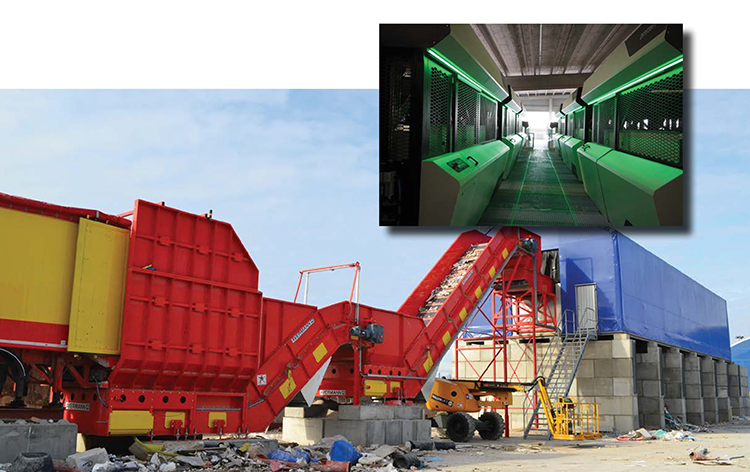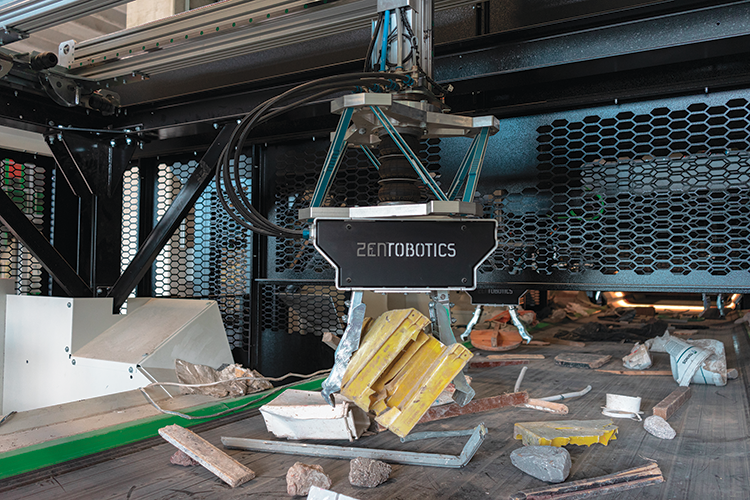Customers, consumers and regulators alike are calling for higher recycling rates and more ambitious circular economy goals across the world. As a result, leading waste operators are beginning to modernize their facilities with smart automation.
By Juha Miestkonen
We are facing a global resource shortage, and that wakeup call is getting louder by the day. It forces us to change the way we use and reuse existing resources across industries. Luckily, there is already a major source of high-purity secondary raw material just waiting to be used in full scale—and recycling companies are sitting right on top of it.
Customers, consumers and regulators alike are calling for higher recycling rates and more ambitious circular economy goals across the world. To turn these increasing demands into a lucrative business opportunity, leading waste operators are moving away from inefficient and costly, old, labor intensive processes. Instead, they are modernizing their facilities with smart automation.

Below: Unmanned and independent robotic sorting station at Carf F in Sweden.
Major Investments in Europe
In Europe, we have recently seen major investments into fully automated material recovery facilities (MRFs) on an industrial scale that are shaking up the industry. In Finland, Remeo has invested in the continent’s most advanced fully robotized plant that integrates C&D and C&I waste lines, with a capacity of 30 tons per hour (t/h) and 15 t/h respectively. At the Remeo MRF, 12 heavy picker robots pick different qualities of wood, metals, stone, and plastics from C&D waste, and together perform up to 24,000 picks per hour. These high-purity materials are recycled into high-quality alternatives to virgin materials, giving the waste a new life and reducing the need for incineration.
Swiss-based The Eberhard Group is using smart robots to capture valuable high-purity secondary materials from mixed C&D waste at 200 t/h. Multiple high-capacity, heavy-duty
robots on two parallel sorting lines pick 12,000 items per hour with up to 30-kilogram weight, separating mineral materials and foreign impurities from the stream. The end result is a new circular raw material that matches the quality of virgin raw materials and can be used to replace primary building materials.
Key Benefits of AI
These next generation MRFs are showing that advanced AI and robot technologies are becoming a new standard in modern recycling facilities. But there is also a faster way for operators to get the full benefits of AI-based sorting at their site. Many are opting for an unmanned robotic sorting station that runs independently from other operations and is quick and easy to install. Below are the key benefits for operators.
Sort Multiple High-Quality Recyclables from Bulky C&D Type Waste in One Go
The reason why smart robots offer the best solution for waste sorting is because they are just that—smart. They can recognize, sort and recover multiple high-purity materials on the spot completely on their own and with up to 99 percent purity. The key feature of AI-powered robots is that they are not only sorting, but they are also scanning the waste—even 24/7. This results in a constant flow of new data on the waste composition and deeper understanding of waste. Modern MRF operators can then use this data to discover and add new, sometimes even unexpected recyclables on top of their usual sorting targets.
Bjorstaddalen, a MRF operator in Norway, is taking advantage of the robots’ learning process. Their unmanned robotic sorting station is recovering fractions such as A, B, and C (hazardous) wood, non-ferrous metals, rigid PE and PP plastics, black plastics and inert at up to 6,000 picks per hour. Having seen how the robotic plant can also be trained to recognize new materials too, the company has entered into new agreements with several downstream buyers who are interested in using the sorted materials as secondary raw material, instead of incineration. Bjorstaddalen considers the flexibility intaking in and sorting new waste materials beneficial in preparing and adapting to changing recycling requirements and reducing the CO2 emissions.

Photos courtesy of ZenRobotics.
Extend Sorting Capacity and Efficiency with Autonomous Operations
Automation also boosts efficiency and profitability. This is because waste sorting robots offer the quickest and most accurate way to pick desired materials out of your waste streams and can operate around the clock. As they are powered by AI, they require little human involvement. Before robots come into play, the material first goes through a simple screening step where fines and fluffy lightweight material are first sorted out. The material is then loaded into a feeding bunker where the material flows evenly and is autonomously dosed to the robots through a feeding bunker. The AI-powered robots then work independently, emptying the bunker day and night.
The inclusion of robotic sorting to replace or complement manual processes also has an important impact on the facility’s safety. Simply put, automation means lower risks associated with manual sorting. Smart robots can pick up waste that weighs up to 66 lbs (30 kilograms) without breaks—which would be neither safe nor feasible for humans. This allows employees to move to higher value work while also cutting facility downtime.
Danish environmental services company Solum A/S has recently invested in a new robot waste sorting plant where multiple robot arms handle up to 4,000 picks per hour. This is compared to a human sorter that could handle approximately 500 to 700 picks per hour of heavy objects and could not work 24 hours a day without breaks. Swedish waste management company Lundstams Återvinning AB, on the other hand, reduced the amount of waste that needed to be incinerated with robotics, resulting in cost savings of about $22,000 USD (20,000 euros) each month compared to the time when a sorting robot was not in use.
Flexible Use and Easy Installation
Upgrading recycling operations with AI-powered robots makes your facility smarter, and operating the robot, fortunately, does not require magic skills. The robots are trainable by operators themselves, making it easy to adjust sorting results as desired and adapt to changes in their waste. With remote access and online diagnostics, operators can study their waste composition and feeding quality—and make changes to recovery, throughput and purity to match the production targets.
An autonomous robotic sorting station can be set up independently from all other operations, requiring only some space onsite. This makes it easy to get the full benefits of an AI-powered robot without major facility investments, complex plant designs, or huge civil works. Thanks to the flexibility and sorting capacity of the robot, it does not require heavy volumes for profitable operation either, making it possible for facilities with small to mid-sized waste streams to achieve economies of scale efficiently.
Getting a Head Start in Robotic Sorting
First experiences with sorting robots can eventually lead to more. For example, Zurich-based Spross AG began their cooperation with Zenrobotics in 2019 with an aim to increase the efficiency of their waste recycling and decided to double their robot count recently to earn more from valuable fractions like concrete and stone, as well as wood, plastics, and some metal. Remeo in Finland took on AI-based robots in 2010 to improve the cost-efficiency and recovery rate of waste sorting, only to build Europe’s largest facility designed around this technology a decade later. Similarly, the Eberhard Group made their first investment into smart autonomous waste sorting robots back in 2015.
All facts point to an inevitable future where robotized systems will make up an integral part of the recycling industry and leading operators are getting a head start already now. If you are curious about these systems, there are multiple sites across the globe where you can see them in action or get in touch with providers to find the nearest one to you. | WA
Juha Miestkonen is Head of Sales for ZenRobotics, a leading supplier of intelligent sorting robots for the waste industry and the first company to apply AI-based sorting robots to a complex waste-sorting environment. Their intelligent robots, powered by their very own advanced AI software, make recycling more efficient, accurate and profitable. ZenRobotics’ ambition is to make the circular economy a reality by turning global waste into clean raw materials. They call on all forward-looking companies to re-think the waste industry for the decades to come. If you want to take a leap forward on your path to success, get in touch with ZenRobotics today. For more information, e-mail [email protected] or visit www.zenrobotics.com.
